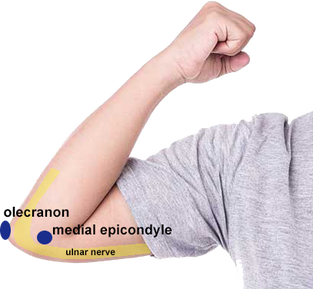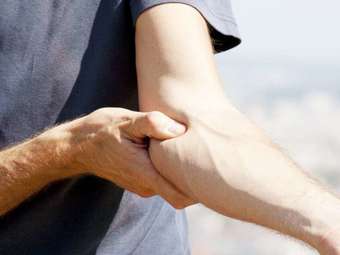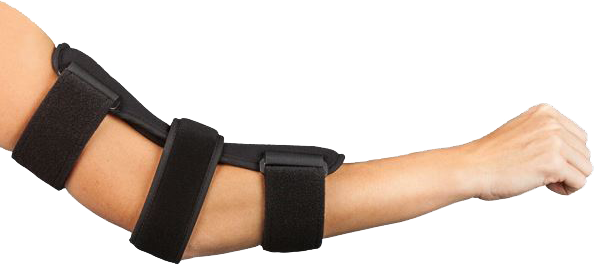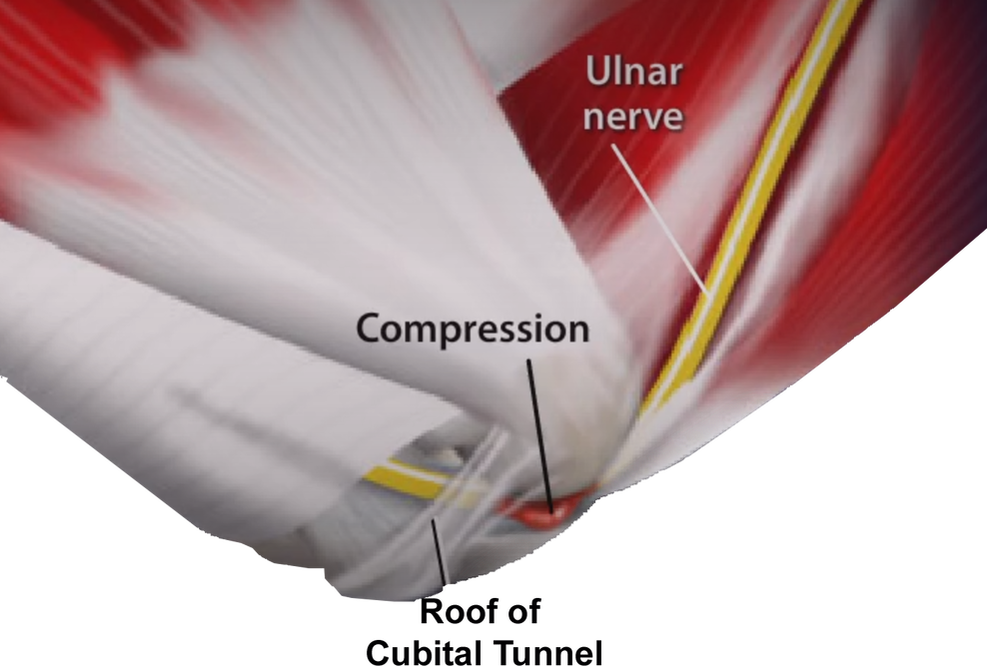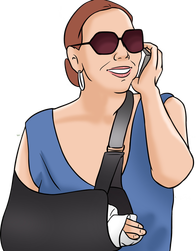The funny bone's little nerve problem.
If you have ever hit your elbow joint on something and felt a strange, searing pain running from the elbow up through the arm, you will likely have said that you hit your "funny bone." This, however, is ulnar nerve compression.
An occasional incident of the funny bone discomfort will happen to just about everyone. However, if it is a regular occurrence, you may have an issue with the ulnar nerve, and it can result in nerve damage if not checked by a professional.
An occasional incident of the funny bone discomfort will happen to just about everyone. However, if it is a regular occurrence, you may have an issue with the ulnar nerve, and it can result in nerve damage if not checked by a professional.
What is Cubital Tunnel Syndrome
|
The cubital tunnel is where the ulnar nerve courses through the elbow. As the nerve passes through the elbow, it is bound by the olecranon and the medial epicondyle. These two bony structures hold the nerve within the groove to stay properly.
Along the course of the nerve, there are multiple points where ulnar nerve entrapment by surrounding tissues can occur and cause problems with the hand. Landmarks on the skin to show the course of the ulnar nerve in the elbow When an individual keeps the elbow bent frequently (pulling, reaching, lifting), leans on the elbows, or incurs an injury, a common result is cubital tunnel syndrome. In other situations, arthritis, bone spurs, and fractures from the past may be the onset of cubital tunnel syndrome. |
How do you diagnose cubital tunnel syndrome?
|
The diagnosis of cubital tunnel is made using a combination of physical exam and electromyography (EMG). Symptoms of cubital tunnel include hand numbness in the ring finger and pinkie finger, weakness with grip strength, weakness with pinch strength, loss of fine motor function in the hand, pain that radiates from the elbow to the hand and feelings of electrical shock travelling from the elbow to the hand.
|
How do you treat cubital tunnel syndrome.
|
Conservative management of cubital tunnel include rest, physical therapy and bracing. Conservative management is usually the first step in the process of treatment. Surgery is reserved for severe cases or when the nerve has severe impairment.
|
Surgical Treatment
|
During the surgery for cubital tunnel, the injured nerve is identified surgically. As seen in the picture, the roof of the tunnel may be a compession site of the nerve. This tissue is released and the nerve is freed of its attachments. Once this is complete, the nerve can be left in place or moved to a different position to prevent it from being compressed.
|
Rehabilitation
|
We love when we get to write very short recovery protocols. Cubital tunnel is a very easy recovery! Instant return of sensation and strength to the arm are noted by most patients. The elbow is kept in a regular sling for 3 weeks. After 3 weeks, PT may be initiated but is not necessary! Most people return to full function at 3 months with no residual symptoms.
|
Symptoms: Cubital Tunnel Syndrome
The symptoms of cubital tunnel syndrome in the ulnar nerve may mimic other health conditions like the medial epicondyle (golfer's elbow), so it is important to discuss the onset of your symptoms with your bone joint health care provider.
The most common symptoms of cubital tunnel syndrome include:
The most common symptoms of cubital tunnel syndrome include:
- Numbness and tingling in hand, especially when the elbow is bent
- Numbness and tingling in the ring and little finger, especially with a bent elbow
- Hand pain
- Weak grip
- Weak pinch strength
- Loss of fine motor function in the hand
- Clumsiness is caused by muscle weakness in the problem hand and arm
- Pain on the inside of the elbow
- Feeling of electrical shock from the elbow to the hand
How Do You Diagnose Cubital Tunnel Syndrome in the Ulnar Nerve?
The diagnosis of the cubital tunnel will include a review of your medical history and a physical examination. After that, our doctors will use diagnostic tests to determine whether the patient has cubital tunnel syndrome.
Cubital tunnel syndrome diagnosed by medical professionals will be done with the following tests:
A patient with a cubital tunnel who has pain right in his forearm.
Cubital tunnel syndrome diagnosed by medical professionals will be done with the following tests:
- Nerve conduction study - a measurement of the speed that signals travel down the nerve to find nerve compression or constriction of the nerve
- Electromyogram (EMG) - determines nerve and muscle function and can be used for the forearm muscles controlled by the ulnar nerve.
- This diagnostic test can see X-rays of arthritis and bone spurs in the elbow.
A patient with a cubital tunnel who has pain right in his forearm.
How Is Cubital Tunnel Syndrome Treated?
Conservative management is used to treat cubital tunnel syndrome, including rest, physical therapy, anti-inflammatory medications, and bracing. These methods are usually the first step in the process of treatment. Surgery on the ulnar nerve is reserved for severe cases or when the nerve has a severe impairment.
An elbow brace is used at night to keep the elbow at 45* to avoid nerve compression. Compression of the nerve usually occurs at 90* of bending for a prolonged time.
An elbow brace is used at night to keep the elbow at 45* to avoid nerve compression. Compression of the nerve usually occurs at 90* of bending for a prolonged time.
Surgical Treatment
During the surgery for cubital tunnel syndrome, the injured ulnar nerve is identified surgically. As seen in the picture, the roof of the tunnel may be a compression site of the nerve. This tissue is released, and the nerve is freed of its attachments. Once this is complete, the nerve can be left in place or moved to a different position to prevent it from being compressed.
The anatomy of the cubital tunnel. The compression site is usually near the roof of the cubital tunnel. This is released surgically to decrease the pressure on the nerve and help you get better!
The anatomy of the cubital tunnel. The compression site is usually near the roof of the cubital tunnel. This is released surgically to decrease the pressure on the nerve and help you get better!
Rehabilitation
Our bone and joint experts love when they get to write very short recovery protocols. The cubital tunnel is a very easy recovery! Most patients note the instant return of sensation and strength to the arm. The elbow is kept in a regular sling for only 3 weeks. After 3 weeks, physical therapy may be initiated but is not necessary! Most people return to full function at 3 months with no residual symptoms.
Smile. The sling is only for 3 weeks!
Smile. The sling is only for 3 weeks!
Nerve Gliding Exercises
Any inflammation or adhesions along the ulnar nerve path can cause the nerve to be limited in its mobility. You might end up getting stuck in one place with your elbow and unable to straighten it.
These are designed to prevent cubital tunnel syndrome with nerve gliding exercises by stretching the nerve and encouraging movement throughout the cubital tunnel.
These exercises include elbow flexion test and wrist extension, head tilt, arm flexion in the front of the body, and bending the elbows into an "ok" sign around your face.
These are designed to prevent cubital tunnel syndrome with nerve gliding exercises by stretching the nerve and encouraging movement throughout the cubital tunnel.
These exercises include elbow flexion test and wrist extension, head tilt, arm flexion in the front of the body, and bending the elbows into an "ok" sign around your face.
Are You Suffering from Cubital Tunnel Syndrome? Contact Our Bone and Joint Experts!
If you are suffering from the pain and discomfort associated with cubital tunnel syndrome, contact the experts at Atlanta Bone and Joint Specialists. Our surgeons have the knowledge, skills, and equipment to diagnose your symptoms and determine the best course of treatment for cubital tunnel syndrome.
We use only the cutting edge of technology for all of our procedures, and we are dedicated to helping all of our patients live pain-free. Patient education is also a top priority to know how to prevent serious nerve and joint issues. Contact us today to schedule your appointment!
We use only the cutting edge of technology for all of our procedures, and we are dedicated to helping all of our patients live pain-free. Patient education is also a top priority to know how to prevent serious nerve and joint issues. Contact us today to schedule your appointment!
Office HoursMon-Fri: 9AM-5PM
|
Telephone |
High School Football Season Added Coverage HoursSaturdays During High School Football Season
Injury Clinic is for INJURED PLAYERS ONLY. Snellville ONLY. 9AM-10AM MEDIA ROOM |

